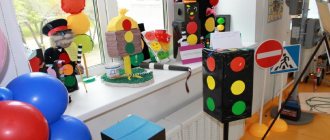Traffic rules in kindergarten
Teaching junior and senior preschoolers in kindergartens the rules of the road (traffic rules) and preventing child injuries on the roads is an obligatory part of the educational process in preschool educational institutions. The requirements specified in the educational program for teaching children the road alphabet should become more complex depending on the age of the children.
In the section of the website, traffic rules in kindergarten for different groups contain many interesting activities for teachers on teaching children on various topics:
- Memo on traffic rules for parents of children of primary preschool age
- Summary of an open lesson on traffic rules
- Formation of safe behavior skills in preschool children through familiarization with traffic rules
- Fairy tale on traffic rules in kindergarten
- Leisure activities for kindergarten children according to traffic rules
- Integrated activity for children of middle preschool age
- KVN on traffic rules in kindergarten
- About the rules of the road (event-game) in kindergarten
- Summary of an open lesson on traffic rules in the preparatory group
- Long-term plan for the second junior group of kindergarten on traffic rules
- Summary of educational activities for children aged 5-6 years on the topic “Travel to the country of safe traffic”
- Notes on traffic rules for children 4-5 years old on the topic “Car”
- Traffic Rules Project
- Summary of educational activities “We are walking along a pedestrian crossing” middle group of kindergarten
- Methodological developments in preschool educational institutions on traffic regulations “Safety on roads and streets”
- A comprehensive lesson in kindergarten on learning traffic rules with preschoolers
- Sports entertainment according to traffic rules for older children
- Pedestrians and transport
- Summary of a lesson on traffic rules in the preparatory group of a preschool educational institution
- Traffic rules for preschoolers
- Holiday scenarios according to traffic rules for kindergarten
- Summary of organized educational activities in the senior group on the topic “In the country of road signs”
- Diagnostic knowledge sheet on traffic rules for children in the preparatory group for school
- Long-term planning to familiarize children with the traffic rules of the road in all age groups of kindergarten
- Preschoolers about traffic rules
- Conversations, leisure, entertainment, games on traffic rules for preschool children
- Studying traffic rules with preschoolers
- Scenarios for morning performances on traffic rules in kindergarten
- Holiday scenarios according to traffic rules for kindergarten
- Lesson notes on traffic rules for kindergarten
- Holidays according to traffic rules in kindergarten
- Preschoolers about traffic rules
- Studying traffic rules with children in kindergarten
The child must not only remember the rules of the road, but also answer the question asked clearly and thoroughly. However, teachers and parents must understand that learning the material occurs gradually, so it is not worth overloading the child’s brain with a large amount of information. Classes on traffic rules in kindergarten for preschoolers of different age groups.
Teaching children traffic rules is an integral part of the educational process. Considering the statistics on completed DPPs in our country, this problem is very relevant in our time. Today, kindergartens and schools are responsible for developing in children a system of skills and knowledge about safe behavior on the roads. Educators and school teachers play an important role in children’s learning of traffic rules.
Each kindergarten has developed a program that teaches children traffic rules. The first basics are in the younger group, and preschoolers-future first-graders should already know by heart road signs for pedestrians and the basic rules of proper behavior on the street. The preschool file cabinet contains methodological instructions for teachers and instructions for parents of preschool children, lesson notes so that children learn the rules of safety on the street, road signs, themed walks and holidays, the main theme of which is traffic rules and the behavior of children on city streets.
Teaching traffic rules in kindergarten is a vital necessity, therefore various activities on traffic rules are always relevant in preschool educational institutions. In kindergarten, a child must master the basic concepts of the traffic system and learn the most important rules of behavior on the road. Traffic rules in kindergarten are a fairly large set of knowledge that educators try to convey to children, because their safety on the road depends on it.
Corners on traffic rules in kindergarten are organized in such a way that children play and gain knowledge at the same time. During play activities, they receive information that there are sidewalks, traffic lights, and pedestrian crossings. The task of educators is to teach how to cross the roadway correctly, to tell them that there are signs on the roads that are important for both drivers and pedestrians. In kindergarten, drawings on the topic of road safety can be used to make presentations. For example, after a conversation or lesson, children are asked to take a pencil and a piece of paper and draw any picture they wish on the topic covered.
When it comes to traffic rules for children, then one acute question immediately arises: how to explain everything to a child so that it is interesting and understandable to him? Riddles, poems, proverbs, traffic rules games - that's what can help! Riddles about traffic rules, Riddles about zebras can be downloaded for free on our website for kindergarten teachers.
Lesson summary on life safety “Organization of traffic, responsibilities of pedestrians and passengers”
Traffic management, responsibilities of pedestrians and passengers
Purpose: to consider the principles of traffic management, the responsibilities of pedestrians and passengers.
During the classes
- Repetition of covered material.
- List the main causes of transport accidents:
- inattention of road users;
- failure to comply with safety rules by vehicle drivers and passengers;
- violation of traffic rules by pedestrians;
- transport breakdown;
- unsatisfactory condition of the roadways and streets;
- bad weather conditions.
- List the features of modern transport:
- high speed,
- huge destructive force due to sudden stop and collision,
- high fire hazard.
- Give examples from everyday life of the behavior of road users on the roads, assess their level of culture in the field of road safety.
- State the topic and purpose of the lesson.
The topic of the lesson is “Organization of traffic, responsibilities of pedestrians and passengers.”
Purpose of the lesson: to consider the rules of traffic management, the responsibilities of a pedestrian and a passenger.
- Presentation of program material.
Every day and constantly, thousands of people move along the streets of cities and towns, rushing to work, school, many other places, or returning home. To move in a given direction, people use public transport, personal vehicles (cars, motorcycles, bicycles) or walk. All of them are road users. A road participant is a person who is directly involved in traffic as a driver, pedestrian, or passenger of a vehicle.
In order for this movement to be orderly and provide all participants with the opportunity to quickly and safely move in the direction they need, they must comply with certain rules that regulate traffic on the streets and roads. These are the Rules of the Road.
Currently, the Russian Federation has Road Traffic Rules in force since June 1, 1994, with amendments and additions made in 1998, 2000, 2006, 2012, 2017.
Let us briefly recall the main provisions of the Traffic Rules and key concepts and terms.
In accordance with the Rules, right-hand traffic is accepted in our country, i.e., when driving, vehicles adhere to the right side of the roadway.
A road is a strip of land equipped or adapted and used for the movement of vehicles or the surface of an artificial structure (bridge).
The road includes one or more carriageways, tram tracks, sidewalks, shoulders and median strips. The roadway is intended for the movement of trackless vehicles (cars and trucks, buses, trolleybuses), tram tracks - for trams, sidewalks - for pedestrians, the shoulder - for pedestrian traffic and for stopping cars. A median strip separates adjacent roadways and is not intended for the movement or stopping of vehicles and pedestrians. The dividing strip (like the sidewalk) rises slightly above the roadway. A lawn or fences can be installed on the dividing strip.
To ensure safety on streets and roads, traffic regulation is carried out - controlling the flow of traffic and pedestrians. Road traffic is regulated by road markings, road signs, traffic lights and traffic controllers.
Remember!
Road markings are lines, arrows, inscriptions and other symbols that are applied to various elements of the road. Most road marking lines are white. For example, a white line on the roadway, broken or solid, separates oncoming traffic flows.
A pedestrian crossing is marked on the roadway using road markings.
Pedestrian crossing lines are drawn at intersections or other places convenient for pedestrians. Pedestrian crossings can be marked with solid lines along the roadway along the entire length of the crossing (“zebra crossing”).
Remember!
Road signs, as well as markings, serve to regulate traffic and to convey to its participants the necessary information about various road situations.
There are more than 200 characters. To make them easier to recognize, they are divided into 8 groups:
- Warning.
- Priority.
- Prohibiting.
- Prescriptive.
- Special instructions.
- Informational.
- Service.
- Additional information (plates).
Each group includes signs that convey information of the same meaning.
Remember!
In order to feel confident on the streets and roads and move safely along them, every road user must know the road signs.
To regulate the order of passage of road users through a certain section of the road, traffic lights are used, which have green, yellow and red signals.
Everyone should know this.
A green traffic light allows movement.
A yellow signal prohibits movement and warns of an upcoming signal change.
The red signal prohibits movement.
To regulate traffic, two groups of traffic lights are used: transport and pedestrian.
Transport traffic lights can be three-sectional, with signals arranged vertically from top to bottom: red, yellow, green. Transport three-section vertical traffic lights may have additional sections located horizontally with green arrows indicating the direction of movement of vehicles.
Pedestrian traffic lights are two-sectional and have two vertically located signals depicting a standing pedestrian in red (prohibiting signal) and a walking pedestrian in green (permissive signal). Pedestrian traffic lights are placed on sidewalks on both sides of the roadway.
In some cases, traffic on the roads can be regulated by a traffic controller. He can give signals with his hands, body position, using a baton and flags.
The traffic controller is located in the center of the intersection, on the line separating oncoming traffic flows, or at the edge of the roadway. Signals given by the traffic controller from the center of the intersection or from the center line of the road are mandatory for all road users.
Basic signals given by the traffic controller
- Arms extended to the sides or lowered - pedestrians are allowed to cross the roadway from the right and left sides of the traffic controller.
- The right arm is extended forward - pedestrians are allowed to cross the roadway behind the back of the traffic controller.
- The hand is raised up - movement is prohibited.
Attention!
If you see a traffic controller at an intersection where there is a traffic light, then you must obey his signals.
Many of us are constantly involved in traffic. Each of us, regardless of social status and age, can find ourselves on the road as a pedestrian or passenger in a fixed-route vehicle (bus, trolleybus, tram). And therefore we must know the duties of a pedestrian and a passenger and constantly comply with them. (Remember that our country has the highest rate of deaths in road accidents (15-16) per 100 victims.)
Everyone should know this
- Pedestrians must move on sidewalks or pedestrian paths, and if there are none, along the roadsides. Pedestrians carrying or carrying bulky objects, as well as persons using non-motorized wheelchairs, may move along the edge of the roadway if their movement on sidewalks or shoulders creates an obstacle for other pedestrians.
- If there are no sidewalks, pedestrian paths or shoulders, or if it is impossible to move along them, pedestrians can move along a bicycle path or walk in a single file along the edge of the roadway (on roads with a dividing strip - along the outer edge of the roadway).
- When walking along the edge of the roadway, pedestrians must walk towards the movement of vehicles. Persons moving in wheelchairs without a motor, driving a motorcycle, moped, or bicycle, in these cases must follow the direction of travel of the vehicles.
- When driving along the side of the road or the edge of the roadway in the dark or in conditions of insufficient visibility, pedestrians are recommended to carry objects with reflective elements and ensure that these objects are visible to vehicle drivers.
- The movement of organized pedestrian columns along the roadway is permitted only in the direction of movement of vehicles on the right side of no more than four people in a row. In front and behind the column on the left side there should be escorts with red flags, and in the dark and in conditions of poor visibility - with lights on: in front - white, in back - red.
- Groups of children are allowed to drive only on sidewalks and pedestrian paths, and in their absence, along the roadsides, but only during daylight hours and only when accompanied by adults.
- Pedestrians must cross the roadway at pedestrian crossings, including underground and overground ones, and in their absence, at intersections along sidewalks or roadsides.
- If there is no crossing or intersection in the visibility zone, it is allowed to cross the road at right angles to the edge of the roadway in areas without a dividing strip and fences where it is clearly visible in both directions.
- In places where traffic is regulated, pedestrians must be guided by the signals of a traffic controller or a pedestrian traffic light, and in its absence, a transport traffic light.
- At unregulated pedestrian crossings, pedestrians can enter the roadway after assessing the distance to approaching vehicles, their speed and making sure that the crossing will be safe for them. When crossing a roadway outside a pedestrian crossing, pedestrians must, in addition, not interfere with the movement of vehicles and exit from behind a standing vehicle or other obstacle that limits visibility without making sure that there are no approaching vehicles.
- Once on the roadway, pedestrians should not linger or stop unless this is related to ensuring traffic safety. Pedestrians who do not have time to complete the crossing must stop on the line dividing traffic flows in opposite directions. You can continue crossing only after making sure that further movement is safe, and taking into account the traffic light signal (traffic controller).
- At stopping points that are not equipped with raised landing areas, it is allowed to enter the roadway to board a vehicle only after it has stopped. After disembarking, it is necessary to clear the roadway without delay.
Remember!
Pedestrians cross the carriageway at pedestrian crossings or at intersections. An intersection is a place where two or more roads intersect.
Passenger Responsibilities
In accordance with the requirements of the Road Traffic Rules, passengers are required to wear them when traveling in a vehicle equipped with seat belts, and to wear a fastened motorcycle helmet when traveling on a motorcycle.
Rules for safe passenger behavior in all types of public transport
In a passenger car, the safest place is to the right behind the driver. And the most dangerous thing is the front seat next to the driver. The safest place on the train is on the bottom bunk. When traveling by rail, upon entering the carriage, you need to remove from your luggage everything that you will need on the road before putting it on the luggage rack or in a special compartment in the bottom shelf. Money and documents must be with you. In the event of an accident, you must first save lives, not things!
Boarding of the vehicle is carried out after it has come to a complete stop through the front doors.
If you have a backpack on your shoulders, you need to take it off and hold it in your hands. Girls are advised to always keep their purse in front of them when sitting down, and on their knees when sitting.
Upon entering the salon, you need to look around, choose a comfortable place where you will not be disturbed. You should look at where emergency and emergency exits are located. If there are no free seats in the transport, you should try to stand in the center of the aisle, holding the handrail or special pendants with your hand. You cannot stand at the front door, much less lean on it - it may accidentally open.
It is recommended to move around public transport only when it is completely stopped.
It is necessary to remember that in public transport you cannot make noise, be naughty, talk loudly, or eat ice cream. You cannot lean out of the windows of a vehicle while it is moving, distracting the driver from driving.
Rules of conduct when using trams, buses and trolleybuses:
- Wait for a bus, trolleybus or tram only on the landing platform, and where there is none, on the sidewalk or side of the road.
- When boarding a tram, if the tram tracks are located in the middle of the street, cross the roadway to approach the tram stop. Before crossing, you need to inspect both sides of the road and, making sure that there is no moving traffic, head towards the stopped tram.
- Boarding must be done through the front doors, and disembarking must be done through the rear doors or through doors marked “Exit”.
- After disembarking from public transport, when crossing the roadway, you must be especially careful, given the heavy traffic. When getting off the bus, if you need to cross the roadway, it is safest to walk along the sidewalk to the nearest pedestrian crossing. On a country road where there is no pedestrian crossing sign, you should wait until the bus leaves, inspect the road and, making sure that it is possible to cross safely, cross it.
Rules of conduct on the subway:
- stand on the right, go on the left;
- You cannot run up the steps of the escalator or sit on them.
Behavior on the platform:
- do not go beyond the boundary line;
- If something falls on the rails, do not try to get the item yourself, contact the person on duty.
Rules of conduct when traveling by truck:
- You cannot stand in the back while the truck is moving.
- You cannot move from place to place while moving.
- You can't sit on board.
- You cannot get out of the truck towards the roadway.
- Lesson summary.
- What is a road and what are its components?
- What is traffic regulation intended for and how is it carried out?
- Who are road users and what general responsibilities are assigned to pedestrians and passengers?
- What safety measures must be observed by pedestrians and passengers as road users?
- What qualities of a pedestrian can characterize the level of his general culture in the field of road safety?
Homework
From the Traffic Rules, select road signs that regulate the movement of pedestrians on the road. Write it down in your notebook.
From the Traffic Rules, select the traffic light signals that a pedestrian should follow when crossing the road. Write it down in your notebook.



